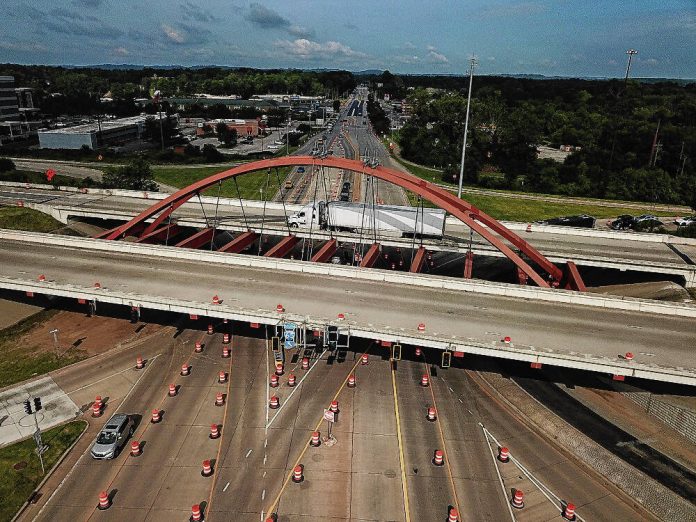
Photo provided In this drone photo provided by INDOT, the iconic bridge that serves as the “gateway” to the front door of Columbus is shown. The cables are visible from the top of the arch moving downward.
The Gateway Arch Bridge carrying Interstate 65 over State Road 46 was a focal point for local and state officials upon its unveiling 30 years ago. Fitting for the midcentury architectural mecca that is Columbus, the bridge was a unique design that boldly signified there was something special here.
Lately, though, the bridge has been a focal point for far different reasons. For many months, traffic restrictions have caused headaches because the unique bridge is showing troubling signs.
The Republic’s Mark Webber took a hard look at the bridge in a piece in last Sunday’s paper. As planners and the community look forward, particularly with changes that may be required with the future widening of I-65 through Columbus, they need to proceed with caution on future designs. In terms of public infrastructure reliability, to be kind, the Gateway Arch Bridge has issues.
There is no doubt that it’s a visually striking structure that has become a landmark for the millions of vehicles that have passed by in the last 30 years. That said, most interstate bridges are designed with lifespans of 50 to 80 years, and the US Department of Transportation in 2006 set a goal of new bridge construction with a 100-year lifespan.
That’s not to suggest this bridge is at the end of its lifespan, but there is cause for concern. Signs of trouble around the bridge became apparent earlier this year when the Indiana Department of Transportation placed a pair of steel support towers beneath the bridge without fanfare, disrupting traffic patterns on State Road 46.
The supports have been there since, with drivers navigating a sea of traffic cones, varying lane restrictions and commute delays in both directions leading to the bridge on State Road 46.
This is because the steel cables from which the bridge is suspended were corroding. INDOT placed the supports as a precaution while installing suspension reinforcements alongside the cables.
This was troubling to read in Webber’s reporting, quoting Natalie Garrett, strategic communications director for INDOT:
“‘The corrosion on the I-65 bridge in Columbus is believed to be a result of moisture that has collected in the cable sheaths over the years that the bridge has been in service,’ Garrett said.
“That leads to a second and possibly larger concern … Those cable sheaths obscure the degree of corrosive damage visible to inspectors. Since the corrosion cannot be seen, Garrett said the only choice for state transportation officials is to be overly cautious.”
When an inspector is unable to assess the safety of a bridge, this is a serious flaw. Particularly when, as Webber wrote, there have been several high-profile suspension bridge failures around the world in recent years.
As Webber reported, officials said the Gateway Arch design has not been replicated elsewhere in Indiana since the Columbus span was built.
In looking forward, planners should take up the challenge of designing an I-65/State Road 46 interchange that can be a model of innovation and last 100 years.




